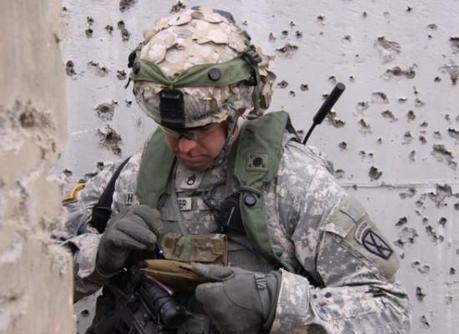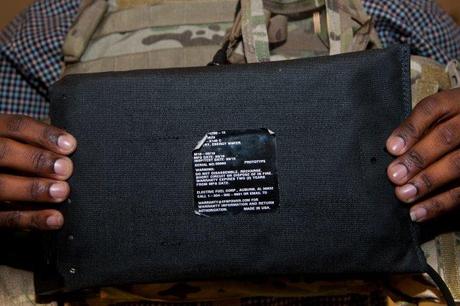
A collaborative effort between the Army Research Laboratory (ARL), Project Manager Soldier Warrior (PM SWAR), the Communications-Electronics Command Logistics and Readiness Center (CECOM LRC), CERDEC Command, Power and Integration Directorate (CP&I) and their industry partners has resulted in what is known as the Universal Battery Charger. The Universal Battery Charger, or UBC, represents the first major update to the standard Army battery charger in almost two decades.
The current Army Standard Battery Charger is based on technology from the 1990s, according to CERDEC CP&I engineer Marc Gietter. Roughly the size of a carry-on suitcase, it is not something a Soldier can carry with him in the field.
“We’re taking that 1990s technology and shrinking it, bringing it into the 21st century,” Gietter said. “It will keep up with today’s technology.”
Two versions of the current Army standard charger exist, explained Ari Herman, a CERDEC Product Realization Directorate engineer who currently supports the CECOM LRC. The first is vehicle mounted and the other is a table-top, stationary device. “While it will charge new batteries, it isn’t optimized for batteries currently used on the battlefield – it does not make efficient use of available space, resulting in a much bulkier charger,” he said.
“There is an increasing need with the networked Soldier for portable power,” said Dave Schimmel, PM SWAR lead engineer. “There is a widening gap between the need for power and the actual availability of that power when the Soldier is in the Tier-1 environment [the most austere environment, such as the remote areas of Afghanistan] so portable power is an absolute requirement.”
The new Universal Battery Charger, or UBC, will be a Soldier-portable charging system, weighing six pounds and smaller than the size of a shoe box. It provides an on-the-move capability, allowing the Soldier to quickly connect to any power source, at any time.
“You can hook this battery charger up to anything that provides power—a generator, fuel cell, solar panel, wind turbine, vehicle cigarette lighter—anything,” Gietter said.
By allowing the charger to connect to any power source it gives the Soldier versatility, which is critical in the ever-changing battlefield environment. The Soldier can quickly tap into the energy provided from a vehicle during transport or connect to a wind turbine, like the one found in another CERDEC CP&I technology, Re-Using Natural Energy, Wind and Solar, or RENEWS.
The UBC will include a foldable solar panel, giving the Soldier yet another option when traditional power is inaccessible, Gietter said.
“The UBC will have more capability, more efficiency and the ability to solve a more universal need for the Warfighter,” Schimmel said.
In line with commercial technology, all new Army rechargeable batteries are “smart,” meaning there is communication between the battery and the end item device or charger. An everyday example of this technology is the battery life indicator on your cell phone.
“Any battery today, much like the battery in a laptop or cell phone, is a smart battery,” Gietter said. “The circuitry tells the charger how it wants to be charged, to do this and not do that. So now, these chargers are smart chargers and will respond to each individual battery.”
Much like any new Army technology, the UBC has strict specifications for rugged conditions the Soldier faces on a daily basis. It must be able to withstand extreme temperatures, humidity, rain, sand and wind. It needs to function while experiencing the bumps and vibrations inside a vehicle. Unlike most commercial electronics, it must also not be destroyed by water.

A flexible battery worn within the Soldier Wearable Integrated Power System, or SWIPES, vest. The new universal battery charger will charge the conformal battery. (Credit: Tom Faulkner)
“The charger will function after being completely submerged in water,” Schimmel said. “It doesn’t have to work under water, but it needs to work after being subjected to a river forging. Soldiers do river crossings as needed for mission execution. We don’t want them to be carrying a six-pound brick after one of those crossings.”
Part of the appeal of a universal charger and the new UBC is its ability to charge different types of batteries with one device and the ability to do so simultaneously.
“The UBC can charge eight batteries and two USB devices at once,” Gietter said. “The USB component is becoming increasingly important as the Soldier moves toward being more connected via a smartphone. It also can charge a morale-boosting device like an iPod.”
Complimentary to the research into the new UBC is continued refinements to the Conformal Wearable Battery, or CWB. The CWB is a flexible battery worn by the Soldier as part of the uniform. It bends to the shape of the body, rather than the Soldier carrying a traditional, rigid rectangular box battery.
“The CWB allows the Soldier to actually wear the battery and have it seamlessly integrated into his uniform, reducing the burden on the Soldier,” Schimmel said. “It feels like less of a weight and may be placed where the Soldier wants it.”
The conformal battery is part of the Soldier Wearable Integrated Power System, or SWIPES, which integrates the charging of radios, GPS, smartphones and other Command, Control, Communications, Computers, Intelligence, Surveillance and Reconnaissance, or C4ISR, technologies into the Soldier’s vest. Each pocket serves as a charging port.
“The conformal battery is the first flexible, full temperature range battery that will actually top-charge all C4ISR technologies,” Herman said. A Soldier can charge devices as they sit in the pockets of his vest, rather than having to swap in new batteries during combat.
The position of the battery is crucial. It can be integrated into the vest in an area that normally is unusable anyway, like under the Soldier’s arm, rather than placing it in a pocket that could be holding something more vital like ammunition, Schimmel explained.
The development of the UBC and refinements to the conformal battery represent a key partnership between several organizations across the lifecycle of Army power and energy technology. Starting at the fundamental research and basic chemistry of batteries and electronics is ARL. The fundamental research is then transitioned to CERDEC, which further develops it into a working and realistic technology. PM SWAR evaluates the technology and gathers feedback from the Soldier to determine if it effectively meets their needs. The LRC completes the lifecycle by working out production contracts, long-term support and sustainment efforts.
The Training and Doctrine Command and the PM help to identify capability gaps and keep the focus on technologies that meet the current mission and the future warfighter needs. They represent the user from the very fundamental research to the logistics and support, Schimmel said.
“This team has been working together on developing new technology for the Warfighter, then evaluating and testing the results for many years now,” Schimmel said. “From engineers, the PM and the acquisition side, to the actual test labs, developers and integrators, we have been working collectively to focus on targeted solutions for the Warfighter together as a team. We have accomplished all that we have due to focused efforts as a team working collectively.”
The organizations leverage each others’ expertise as they work toward the same common goal.
“Any battery anywhere is really what it boils down to—for the Soldier to have the ability to charge any battery in any environment,” Gietter said. “We are giving the Warfighter a desperately needed power source.”

